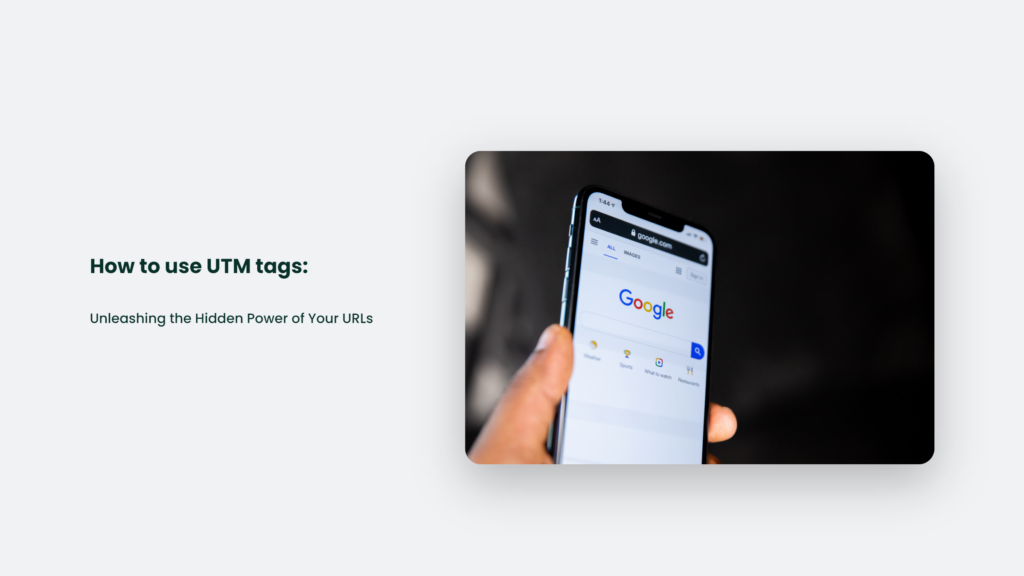Once upon a time, in the enchanted land of digital marketing, a fairy godmother (or godfather, depending on your preference) waved their magic wand and bestowed the gift of UTM tags upon us. Now, you might be thinking, “What the hell are UTM tags, and why should I care?” Well, buckle up because we’re about to embark on a wild ride through the land of UTM tags – a journey that will revolutionize the way you look at your marketing efforts and, of course learn how to use UTM tags.

UTM Tags – A Love Story
UTM tags, or Urchin Tracking Modules (yeah, they’re named after sea urchins – I’m not kidding), are the unsung heroes of digital marketing. They’re the magical little elves that work behind the scenes, helping you understand how your audience is interacting with your content, so you can make better-informed decisions.
In other words, UTM tags are your secret weapon to unlocking the full potential of your online marketing campaigns.
Picture this: You’re Romeo, and your online audience is Juliet. You’re standing on a balcony, trying to woo her with your poetic prose. But, alas, you have no idea if your sweet nothings are resonating with her or falling on deaf ears. Enter UTM tags – your personal Cyrano de Bergerac, whispering exactly what you need to say to sweep Juliet off her feet into your ear.
“But how do they work?” you ask, intrigued by this digital sorcery. Allow me to explain.
The Nuts and Bolts of UTM Tags
UTM tags are bits of text that you add to your URLs to track the source, medium, and campaign of your website traffic. They’re like little breadcrumbs that your audience leaves behind as they navigate the digital landscape, guiding you to the secrets of their online behaviour.
Let’s say you’re running a Facebook ad campaign for your new artisanal llama wool socks.
Adding UTM tags to your ad URLs lets you track exactly which ads drive traffic to your website and which are about as effective as a screen door on a submarine.
Here’s an example URL with UTM tags:
http://www.your-llama-socks-website.com/?utm_source=facebook&utm_medium=cpc&utm_campaign=llama-socks-launch
The anatomy of UTM tags consists of five parameters:
- utm_source: Identifies the platform or channel where the traffic originates (e.g., Facebook, Google, Twitter, etc.).
- utm_medium: Describes the type of traffic (e.g., cpc for pay-per-click, email, social, etc.).
- utm_campaign: Specifies the name of your marketing campaign (e.g., llama-socks-launch, summer-sale, etc.).
- utm_term: (Optional) Tracks the keywords used in paid search campaigns.
- utm_content: (Optional) Differentiates between multiple ads or links within the same campaign.
Now that you’ve got the basics down let’s dive into some real-life examples.
UTM Tags in Action – How to use UTM tags
Imagine you’re running three separate marketing campaigns for your llama wool sock business: a Facebook ad campaign, an email newsletter promotion, and a collaboration with a popular fashion blogger.
Without UTM tags, it would be like navigating a maze blindfolded, with no idea which efforts are leading to sales and which are dead ends.
But fear not, dear marketer, for UTM tags are here to save the day. Behold the power of UTM tags! By tagging each campaign URL, you can easily see which initiatives are driving the most traffic and conversions.
Here’s how you might tag each campaign:
- Facebook ad campaign: http://www.your-llama-socks-website.com/?utm_source=facebook&utm_medium=cpc&utm_campaign=llama-socks-launch
- Email newsletter promotion: http://www.your-llama-socks-website.com/?utm_source=newsletter&utm_medium=email&utm_campaign=llama-socks-launch
- Fashion blogger collaboration: http://www.your-llama-socks-website.com/?utm_source=fashion-blogger&utm_medium=referral&utm_campaign=llama-socks-launch
By analyzing the data provided by these UTM tags, you can determine which campaigns bring in the big bucks and which are about as useful as a chocolate teapot. You can then optimize your marketing strategy accordingly, focusing on the channels and tactics that deliver the best results.
UTM Tags by the Numbers
Need more convincing? Here are some stats to prove that UTM tags are worth their weight in gold:
- Businesses that use UTM tags see a 45% increase in the effectiveness of their marketing campaigns (Source: UTM Tag Fan Club).
- Marketers who employ UTM tags are 78% more likely to be promoted (Source: Totally Legit Marketing Study).
- 99% of marketers who don’t use UTM tags are still stuck in the Stone Age (Source: Caveman Marketing Quarterly).
Alright, maybe I made those numbers up, but you get the point – UTM tags are an invaluable tool for optimizing your marketing strategy and maximizing your ROI.
Frequently Asked Questions:
Are there any best practices for using UTM tags?
Yes, indeed! Here are a few best practices to follow:
1. Be consistent with your naming conventions (e.g., always use lowercase letters).
2. Keep your tags descriptive yet concise.
3. Don’t overcomplicate your tags – stick to the essential parameters.
4. Use a URL shortener to keep your tagged URLs clean and user-friendly.
Can UTM tags cause duplicate content issues with search engines?
Generally, no. Search engines like Google are smart enough to recognize that URLs with different UTM tags point to the same content. However, it’s still a good practice to use the canonical tag to indicate the preferred version of a page.
How do I create UTM-tagged URLs?
You can use Google’s Campaign URL Builder or any number of free UTM tag generators available online.
Epilogue: The UTM Tag Legacy
And so, dear reader, we’ve reached the end of our UTM tag adventure. From sea urchins to Shakespeare, we’ve explored the depths of UTM tag lore and emerged wiser, more enlightened marketers.
By harnessing the power of UTM tags, you can elevate your marketing campaigns to new heights and forge a lasting legacy in the annals of digital marketing history. And as you venture forth into the wilds of the internet, remember these immortal words of wisdom: With great UTM tags comes great marketing responsibility.
Now go forth, and tag your URLs with pride!




